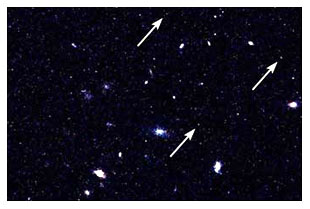BALTIMORE, Jan. 14 -- Researchers using NASA's Hubble Space Telescope reported they are seeing the conclusion of the cosmic epoch called the "Dark Ages," a time about a billion years after the big bang when newly formed stars and galaxies were just starting to become visible.

"With the Hubble Telescope, we can now see back to the epoch when stars in young galaxies began to shine in significant numbers, concluding the cosmic 'dark ages' about 13 billion years ago," said Haojing Yan, a Ph.D. graduate student at Arizona State University (ASU). The results are being presented at the meeting of the American Astronomical Society in Seattle, WA.
Current theory holds that after the big bang that created the universe, there was a time of expansion and cooling that lead to what is known as the "dark ages" in cosmic terms. The universe cooled sufficiently for protons and electrons to combine to form neutral hydrogen atoms and block the transmission of light. This epoch started about 300,000 years after the big bang, and may have ended about a billion years later. Stars and galaxies started to form at some point during this era, but the omni-present neutral hydrogen in the universe absorbed the ultraviolet light produced by stars and can not be seen by current telescopes.
The ASU team reports that Hubble's advanced camera for surveys (ACS) is revealing numerous faint objects that may be young star-forming galaxies seen when the universe was seven times smaller than it is today and less than a billion years old.
This was an important transition in the evolution of the universe. Because ionized hydrogen does not absorb ultraviolet light as easily as neutral hydrogen, the Dark Ages came to an end when enough hot stars had formed that their ultraviolet light pervaded the universe and re-ionized the neutral hydrogen. The shining stars opened a window for astronomers to look very far back into time.
"The objects we found are in the epoch when the universe started to produce stars in significant numbers —- the hard-to-find young galaxies," says Rogier Windhorst, professor of astronomy at ASU. "These galaxies are at the boundary of the directly observable universe."
The ASU team found the objects while examining a small portion of the sky in the spring zodiacal constellation Virgo. This particular area of the sky contains no known bright galaxies, helping reduce light contamination in the observations. The entire ACS field of view shows about thirty such faint red objects. The distances to the suspected young galaxies are believed to be quite large, based on how red the observed objects are compared with nearby galaxies.
Based on this sample, the ASU researchers estimate that at least 400 million such objects filled in the entire universe at this cosmic epoch, to the limit of this Hubble image. And, they say they are able to see only the tip of the iceberg with current telescopes such as Hubble. NASA's planned 7-meter James Webb Space Telescope is expected to see the entire population of these proto-galactic objects after it is launched in 2010.
For more information, visit: http://hubble.stsci.edu